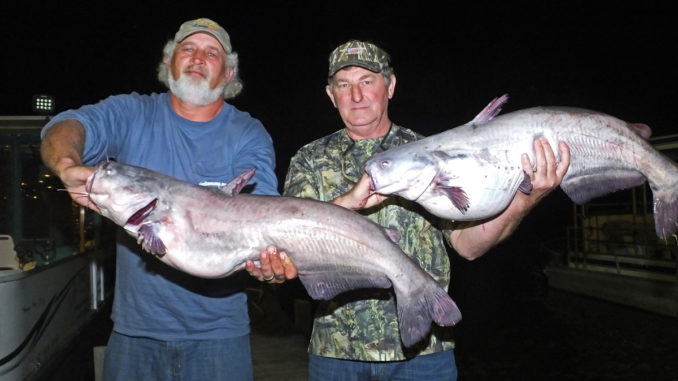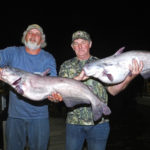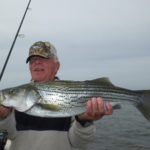
Ol’ Man Winter may still have his icy hand on the weather on occasion, but by February, some fish species on Santee Cooper are a bit too shallow-minded to care.
Crappie are certainly making a big move to the shallows. The major push is typically in March for much of the lake, but crappie fishermen on Lake Marion and Lake Moultrie report that some of the largest fish of the year can be taken during February working the mid-depths to shallow water.
Crappie anglers work brush and woody cover in the 10-foot depth range and into the shallow water on both lakes. Two basic techniques will produce; one is a tight-line rig with jigs, minnows or a jig/minnow combo worked over, around and even into the brush. A second is to anchor just off the target and cast jigs to the target. Both techniques will pinpoint large concentration of slabs at this time of year, but it often means having to move to several potential targets before finding fish.
The ring of water around Lake Moultrie is laced with many canals and slightly deeper ditches, providing access to several depths of water for big crappie lurking in the shallows.
One excellent technique is to cast a small jig on light line around shallow cover. A slow steady retrieve is best; let the lure free-fall a couple times during the retrieve, keeping a taut line, to check different depths. Another good technique used in the swamp portion of Lake Marion, as well as in Lake Moultrie, is to set a float at a depth to fish a jig or minnow in shallow water without snagging. Often, fish will be in 3 feet or less of water; the jig should be rigged about 2 feet deep. The rig can then be fished steady or with a stop-and-go or pause-and-twitch retrieve. This keeps the lure just above the underwater cover and enables an angler to cast to stumps, trees, brush or other targets and fish tight to cover.
An overlooked opportunity in February is striper fishing. Stripers begin a move in both lakes toward current as the urge to move upstream strengthens. In Lake Marion, a few big stripers will typically begin moving up the river in February. The action is not fast-paced until late in the month or early March, but the chance of hooking large stripers is realistic. An even better opportunity this month may be fishing in the Diversion Canal area.
Guide Leroy Suggs, who fishes for stripers year-round out of Blacks Camp, said the urge to move seems to impact fishing beginning in February.
“The stripers in Lake Moultrie begin to move out of the deeper water near the Pinopolis Dam in February and seem to congregate in and around the Diversion Canal,” Suggs said. “Plenty of current flow is the norm for the Division Canal, and that seems to help attract and hold the fish. A variety of techniques produce, and using live bait on or near the bottom around points and pockets and underwater objects that create eddies is high on my list. I also have a lot of success casting bucktails, as well as jigs with soft plastics, around the rocky area that fall into deeper water.”
Suggs (910-995-1168) said stripers will be found in places where plenty of forage is located. That can change daily and weekly and can be impacted by weather as well as a change in current flow from more to less current or vice versa. Suggs said to look for baitfish near the shallows and work those areas thoroughly. It is a good time of the year to catch keeper stripers, as well as good numbers of catch and release sized stripers.
“With a little effort searching to locate the right place, we can usually find big groups of stripers, and because of the prespawn mode and stripers beginning to make a move, hefty stripers are caught at this time of year,” Suggs said.
Catfish are still in a deep-water mode in early February, but later in the month, they’ll begin to show signs of shallow thinking as well.
Catfish expert Richie Wimmer of Cross said for much of the month, the big catfish are deep.
At the beginning of the month, catfish are typically still packed in the deeper holes in both lakes, although I basically fish Lake Moultrie,” Wimmer said. “I fish both lakes a lot, but Moultrie gets the edge during February.
“It is a good month to catch a big catfish, as well as decent numbers,” he said. “I usually begin the month fishing in 50 to 55 feet of water, where plenty of forage is found. I use big chunks of mullet as well as gizzard shad and will typically drift. I’ve also found that the daytime bite is often better during February, so that’s when I focus my efforts.
“It does sometimes require patience and determination to catch a lot of catfish during February. The key is to mark forage and big fish on the graph and work different area until I find biting fish. Some days it’s the first stop; other days I have to move off of a situation that looks good but isn’t producing. Be willing to do that, and you’re odds of success soar.”
Largemouth bass also make a move toward the shallows in February. Both lakes typically produce hawgs this month, and the keys are to fish the underwater creeks, ditches and holes that lead from deep to shallow water. Typically, this is moving month for bass, and they may not be in the shallows in huge numbers, but you can bet they are on the way, and that’s where to fish.







Be the first to comment